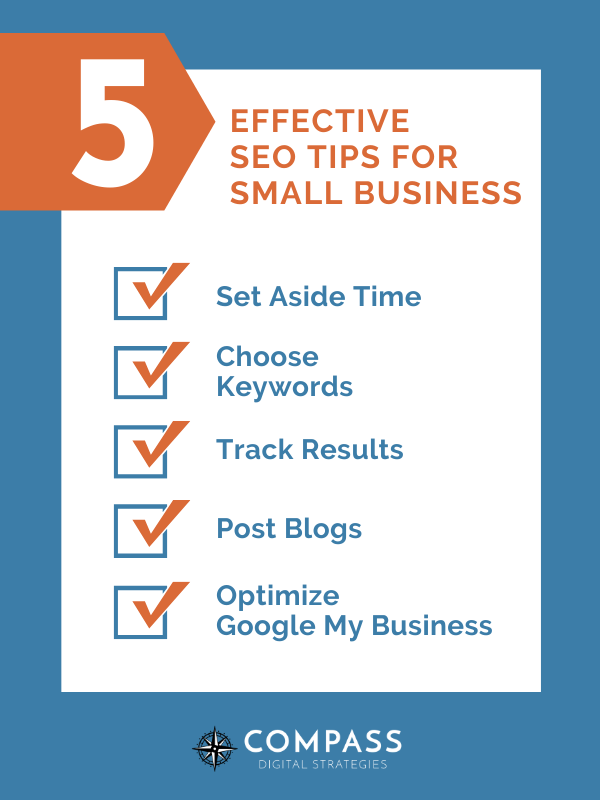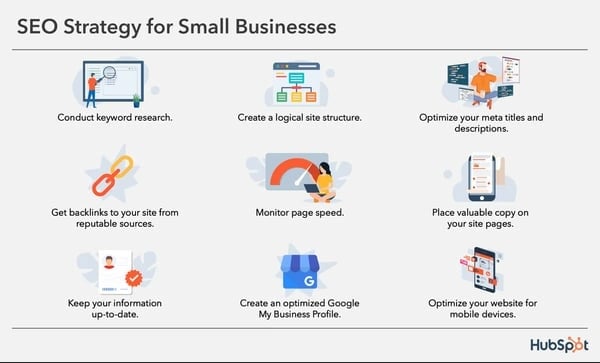Uncover the secret to boosting your small business’s online visibility with these powerful and proven SEO strategies. Don’t miss out!

Image courtesy of via DALL-E 3
Table of Contents
Introduction to SEO for Small Businesses
In today’s digital age, small businesses need to have a strong online presence to compete in the market. This is where SEO comes into play. SEO, which stands for Search Engine Optimization, is a crucial strategy that helps small businesses improve their visibility on search engines like Google. In this beginner’s guide, we’ll explore what SEO is all about and why it is essential for small businesses to succeed online.
What is SEO?
SEO is like a magic wand that can make your website appear higher in search engine results. When potential customers search for products or services related to your business, you want to be one of the first results they see. SEO involves optimizing your website’s content, structure, and other elements to rank higher on search engine results pages.
Why Small Businesses Need SEO
Imagine having a fantastic product or service, but no one knows about it because they can’t find your business online. That’s where SEO steps in to save the day. By implementing SEO strategies, small businesses can increase their visibility, attract more customers, and ultimately grow their business. SEO helps level the playing field, allowing small businesses to compete with larger companies without the need for a massive marketing budget.
Getting Started with Keywords
Keywords are the key words and phrases that people type into search engines like Google when they are looking for information. These words are crucial for your website to show up in search results when someone searches for something related to your business.
How to Find the Right Keywords
When starting with SEO, it’s important to choose the right keywords that describe your business accurately. Tools like Google’s Keyword Planner can help you identify popular search terms in your industry. Think about what terms potential customers might use to find your products or services and incorporate those keywords into your website content.
Using Keywords Effectively
Once you have identified the right keywords for your business, it’s important to use them effectively throughout your website. Make sure to include your keywords in titles, headings, and the main content of your pages. This helps search engines understand what your website is about and improves your chances of ranking higher in search results.
Creating Quality Content
When it comes to SEO for small businesses, creating quality content plays a vital role in boosting your online presence. In this section, we will delve into what makes content stand out and how it can help improve your search engine rankings.

Image courtesy of compassdigitalstrategies.com via Google Images
What Makes Good Content?
Good content is like a magnet that attracts visitors to your website. It includes blog posts, articles, and other forms of information that are both informative and engaging. When crafting content, think about what your audience is searching for and provide answers to their questions. Remember, quality content is not just about stuffing keywords, but about providing value to your readers.
Writing for Your Audience
One of the key aspects of creating quality content is understanding your audience. Write in a way that is easy to read and comprehend. Avoid using jargon or complex language that might confuse readers. Keep your sentences short and to the point. By tailoring your content to the needs of your target audience, you can increase engagement and drive more traffic to your website.
Building Links
In the world of SEO, building links is a crucial strategy to improve the visibility of your website. Backlinks, also known as external links, are links from other websites that point to your site. They are like upvotes in the online world, showing search engines that your content is valuable and trustworthy. Let’s delve into what backlinks are and how you can acquire good ones for your small business website.
What are Backlinks?
Backlinks are like recommendations from other websites. When a reputable site links back to yours, it tells search engines that your content is credible and relevant. These links act as pathways for both users and search engines to discover your website, ultimately boosting your online presence. The more high-quality backlinks you have, the better your chances are of ranking higher in search results.
How to Get Good Backlinks
Acquiring backlinks can be a challenging but rewarding process. One way to get backlinks is to reach out to other websites in your industry and ask if they would be willing to link to your content. Writing guest posts for other blogs is another effective way to gain backlinks, as it provides valuable content to their audience while linking back to your site. Additionally, sharing your content on social media platforms can also attract backlinks from users who find your content useful.
Remember, the key to building a strong backlink profile is to focus on quality over quantity. Aim for backlinks from reputable websites with authority in your industry. By building relationships with other site owners and consistently creating valuable content, you can gradually increase the number of backlinks pointing to your site, ultimately boosting your SEO efforts.
Improving Website Structure
Having a website that is easy to navigate is crucial for both users and search engines. When a website is well-organized, people can find the information they need quickly. Imagine trying to find a specific toy in a messy room – it’s frustrating and time-consuming. The same goes for websites – if visitors can’t easily locate what they’re looking for, they may leave and look elsewhere.

Image courtesy of blog.hubspot.com via Google Images
Using Headings and Subheadings
Clear headings and subheadings are like signposts that guide visitors through your website’s content. They help organize information into easily digestible sections, making it simpler for readers to scan and find what they’re interested in. Think of headings as chapter titles in a book – they give readers a glimpse of what to expect in that section.
Optimizing for Mobile Devices
In today’s digital world, having a website that is optimized for mobile devices is more important than ever. With many people using their smartphones and tablets to browse the internet, it is crucial that your website is easily accessible and user-friendly on all devices.
Why Mobile Optimization Matters
Nowadays, a large number of internet users prefer to use their mobile devices to search for information, shop online, and connect with businesses. If your website is not mobile-friendly, you could be missing out on potential customers.
Search engines like Google also prioritize mobile-friendly websites in their search results, meaning that having a responsive design that adapts to different screen sizes can improve your website’s visibility online.
Tips for a Mobile-Friendly Site
So, how can you ensure that your website looks great and functions well on mobile devices? Here are some simple tips:
- Use a responsive design: Make sure your website layout adjusts to fit different screen sizes.
- Optimize images and videos: Compress images and videos to reduce loading time on mobile devices.
- Simplify navigation: Keep menus and buttons easy to tap on a touchscreen for a seamless user experience.
- Test your site: Use tools like Google’s Mobile-Friendly Test to see how your website performs on mobile devices.
By following these tips and ensuring your website is optimized for mobile devices, you can provide a better user experience for your visitors and improve your chances of ranking higher in search engine results.
Tracking and Measuring SEO Success
When you put in the effort to optimize your website for search engines, it’s important to track and measure the success of your SEO strategies. By keeping an eye on key metrics, you can see what’s working well and where you may need to adjust your approach. Let’s explore how you can effectively monitor your SEO progress and measure your success.
Image courtesy of fitsmallbusiness.com via Google Images
Using Google Analytics
If you’re looking for a powerful tool to help you understand how your website is performing, Google Analytics is your go-to resource. This free tool provides valuable insights into your website traffic, including how many visitors you’re getting, where they’re coming from, and what they’re doing on your site. By analyzing this data, you can make informed decisions about your SEO strategy and content.
Understanding Traffic and Rankings
Website traffic refers to the number of visitors who come to your site, while search engine rankings indicate how well your site is performing in search results. Monitoring these metrics is essential to gauge the effectiveness of your SEO efforts. Increasing traffic and climbing higher in search rankings are clear indicators of SEO success. Keep an eye on these metrics regularly to track your progress and make adjustments as needed.
Local SEO Strategies
Local SEO stands for Local Search Engine Optimization. It’s a way to make sure that your business appears in search engine results when people are looking for products or services in your local area.
Setting Up Google My Business
One crucial step in optimizing your business for local search is setting up a Google My Business profile. This free tool allows you to manage how your business appears on Google Search and Maps.
When setting up your Google My Business profile, make sure to include accurate information about your business, such as your address, phone number, website, and business hours. This will help potential customers find you more easily.
Want to turn these SEO insights into real results? Seorocket is an all-in-one AI SEO solution that uses the power of AI to analyze your competition and craft high-ranking content.
Seorocket offers a suite of powerful tools, including a Keyword Researcher to find the most profitable keywords, an AI Writer to generate unique and Google-friendly content, and an Automatic Publisher to schedule and publish your content directly to your website. Plus, you’ll get real-time performance tracking so you can see exactly what’s working and make adjustments as needed.
Stop just reading about SEO – take action with Seorocket and skyrocket your search rankings today. Sign up for a free trial and see the difference Seorocket can make for your website!
Conclusion and Next Steps
In conclusion, SEO (Search Engine Optimization) is a crucial tool for small businesses to improve their online visibility and attract more customers. By implementing effective strategies like keyword research, quality content creation, link building, website structure optimization, mobile optimization, and local SEO tactics, small businesses can enhance their digital presence and reach a wider audience.
Recap of Key Points
Throughout this article, we have explored the fundamentals of SEO for small businesses, emphasizing the importance of:
- Utilizing relevant keywords to enhance search engine visibility
- Creating high-quality and engaging content to drive organic traffic
- Building strong backlinks to establish credibility and authority
- Optimizing website structure for improved user experience
- Ensuring mobile compatibility for a seamless browsing experience
- Implementing local SEO strategies to target specific geographical areas
Taking Action
Now that you have a better understanding of SEO strategies, it’s time to take action and start implementing what you’ve learned. Remember, SEO is an ongoing process that requires consistent efforts and continuous improvement. Here are some steps you can take to kickstart your SEO journey:
- Conduct thorough keyword research to identify relevant terms for your business.
- Regularly update your website with fresh, engaging content to keep visitors coming back.
- Reach out to industry influencers and websites for backlink opportunities.
- Optimize your website’s structure and navigation for a user-friendly experience.
- Ensure your website is mobile-friendly and responsive across all devices.
- Claim and optimize your Google My Business profile for local SEO.
By implementing these steps and continuously monitoring your progress using tools like Google Analytics, you can effectively improve your website’s search engine rankings and drive more traffic to your small business.







